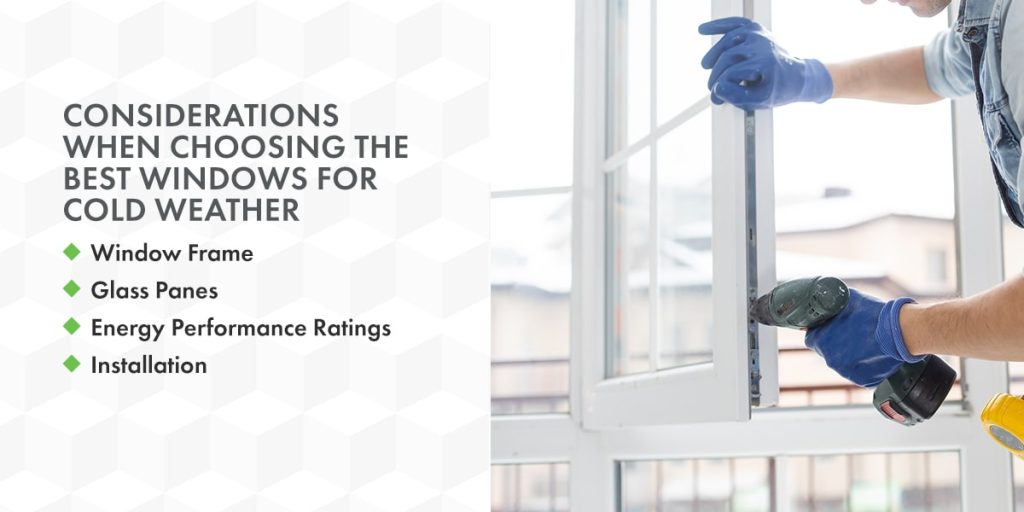

If you live in a cold climate, you understand the value of efficiently and effectively heating your house. Windows serve as a barrier to the cold exterior, though they can just as easily let the cold in. Old or faulty windows can be an obstacle as you try to heat your house, letting warm air escape and forcing your heating system to work harder than necessary.
Replacing your old windows with ones designed for cold weather can make a big difference in your home’s comfort and energy efficiency. Learn the importance of cold weather windows and what to look for when shopping for replacements.
Regardless of what environment you live in, windows can make a significant difference in the comfort and efficiency of your home. Windows for cold environments must be energy efficient and well-insulated. Many people spend significant amounts of money heating their homes in the winter, and your windows’ quality can have a big impact on your energy bills.
Faulty windows or windows not made for cold climates often lack the necessary insulation to keep warm air inside and cold air out. For example, your older windows may not seal properly anymore, which lets cold drafts into your house. When this happens, your heating system has to work harder to maintain a given temperature. Rather than retaining the heat, your windows let the warm air escape, which is highly inefficient and expensive.
High-quality windows for cold climates are designed with more effective insulating properties to help your home retain heat rather than lose it. This can limit how much your heater has to run, helping to reduce your energy bills significantly. The temperature in your home will also stay at a comfortable temperature more consistently with the right windows. Cold weather windows will improve your home’s energy efficiency and help you save money in the long run.

Since windows can be designed for different climates, you need to be sure you’re getting the best windows for cold weather. So, what should you look for in cold weather windows? Several factors can help you determine which windows will be most effective in cold environments. Consider these elements when choosing your cold-weather window replacements.
While the window frame may just seem decorative, it’s actually an integral part of the window to consider. Window frames are often where the most air can leak in and out. If your windows are letting air escape, it’s likely leaking from the:
While no window will be completely airtight, any leaks around the frame should be minimal. If you can feel the cold air coming in, the leak is significant.
Installation and material can also make a difference in the frame’s effectiveness. Consider avoiding aluminum frames in cold climates, as they cannot retain heat efficiently and will allow heat to escape more than other materials. Rather, opt for materials like wood, composite, vinyl or fiberglass, as they’ll help retain heat better. The frame should also be properly caulked to ensure an effective seal around the window’s perimeter.
Panes are the glass panels that sit inside the frame. Most windows are single, double or triple pane. In cold weather, double- and triple-pane windows are most effective. These windows feature two or three glass panes and are typically insulated with krypton or argon. These dense gases are trapped between the window panes to provide more insulation.
Homeowners in colder climates should avoid single-pane windows, as they lack the extra insulation that comes with additional panes. As a result, single-pane windows are less capable of holding in heat.
Window panes can also be treated with filters and various types of coatings to help improve insulation and regulate the light coming into your home. Some window treatments can prevent ultraviolet rays from entering your home while still allowing sunlight in to help warm up your house.
One of the best ways to determine how suitable a window is for cold weather is to look for energy performance ratings like U-factor and solar heat gain coefficient (SHGC). These ratings are used to determine how suitable certain windows are for different climates.
The U-factor measures the window’s insulation. Most windows have a U-factor between 0.20 and 1.20. A low U-factor indicates the window has good insulation, so windows in cold environments should have U-factors as low as possible to ensure energy efficiency.
SHGC is a measurement of how much heat from the sun a window lets into the house. SHGC ratings range from 0-1, with 1 allowing optimal solar heat through the windows. In a colder climate, look for windows with higher SHGC ratings because they’ll help you naturally heat your home on cold days.
Evaluating energy performance ratings when window shopping can help you narrow down your options and ensure you find the most energy-efficient windows for your budget and needs.
While you could buy the most efficient windows on paper, a poor installation could still allow heat to escape. If the window is sized wrong for the space or is installed lopsided, it won’t have a good seal, will let cold air inside and likely won’t last as long. While you may be able to DIY window replacements, there’s a higher risk of errors during installation, which could end up costing you a lot of money in the long run.
It’s best to opt for a professional replacement to ensure the windows are installed properly. The team at Renewal by Andersen works with you from the design phase through installation to ensure your windows are properly installed and will work efficiently.

Are you ready to replace your windows with more efficient ones for cold weather? Work with Renewal by Andersen for high-quality, efficient windows and professional services and installation. We offer various window styles, allowing you to choose what works best for your home. Our products are made with our exclusive Fibrex® material, which offers effective insulating properties and long-lasting strength to help keep your house warm for years to come.
We manufacture each window for your home with custom measurements and specs to ensure the best fit. To get started, contact us online for a free consultation.